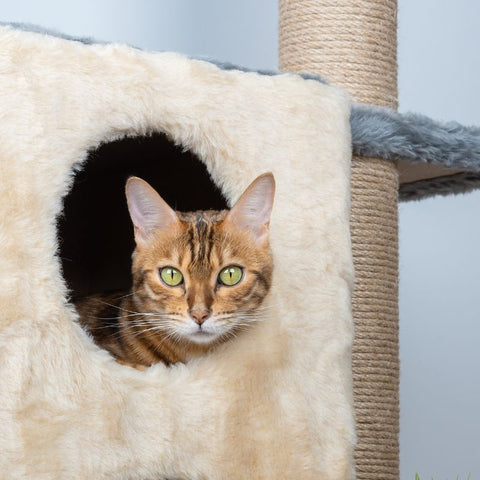How to Welcome Your New Furry Friend: A Guide for New Cat Owners

Congratulations on your new cat! You've gained a loyal companion who will bring joy and comfort for years to come. But before you start cuddling and playing with your new friend, you need to ensure they feel safe and comfortable in their new environment. Cats are sensitive and can easily be stressed by changes, so it's important to follow these tips to help them adjust to their new home and family.
Prepare a Cozy Space for Your Cat
Before bringing your cat home, prepare a cozy, safe space where they can relax and retreat if they feel overwhelmed. This space should include a litter box, food and water bowls, a scratching post, some toys, and a soft bed or blanket. You can use a spare room, bathroom, or a large crate for this purpose. Ensure the space is quiet, clean, secure, and easily accessible. Check out this article to learn how to prepare your home before your cat's arrival. You can also spray some synthetic feline pheromones (available at pet stores or online) to make the space more inviting and calming for your cat.

Gradual Introduction to Their New Home
When you bring your cat home, don't allow them to roam the entire house immediately. Let them stay in their cozy space for a few days until they feel more confident and curious. During this time, visit your cat regularly and spend some time with them. Don't force interaction if they are hiding or hissing. Allow them to approach you at their own pace and reward them with treats and praise when they do. Leaving some of your clothes or blankets in their space can help them get used to your scent.
After a few days, you can start letting your cat explore the rest of the house when it's quiet and no other pets or people are around. Let your cat explore at their own pace without following them or picking them up. If your cat becomes scared or runs back to their space, don't worry. It's normal for them to need time to adjust to their new surroundings. Be patient and supportive, allowing your cat to decide when they're ready to explore more.
Introduce Your Cat to Other Pets
Once your cat is comfortable in their new home, gently introduce them to any other pets you may have. Always take it slow and handle the process with kindness to prevent any potential conflicts. Here's a guide to ensure smooth introductions:
-
Start introducing one pet at a time, keeping the interactions brief and positive. Use treats, toys, and praise to encourage peaceful interactions.
-
Initially, keep your cat and the other pet separated by a door, gate, or screen. This allows them to become familiar with each other's scent and presence without direct interaction. Gradually decrease their distance until they're ready for a face-to-face meeting.
-
If either pet displays signs of aggression, such as growling, hissing, or swatting, separate them immediately and try again later. Don't punish or scold them, as this might increase their stress and fear.
-
Once your cat and the other pet are getting along, they can share the same space under your supervision. Ensure they each have their own food, water, and litter facilities, and separate sleeping spaces. Leave them alone together only when you're confident they're comfortable and friendly with each other.

Introduce Your Cat to Kids in Your Family
Introducing your cat to children in your family requires patience and care. Don't force any interaction between your cat and the kids. Like other pets, cats need time to adapt to their new environment and the people in it.
-
Start by teaching your children how to approach, stroke, and handle cats gently. Encourage respectful behavior and explain that cats can become scared or stressed if treated roughly.
-
Once your cat feels comfortable and ready to interact, gradually introduce the kids. Start with simple steps like gently stroking the cat's fur, using treats to encourage interaction, or playing with cat-friendly toys under your supervision.
-
During these initial interactions, closely supervise the kids and the cat. If the cat shows signs of stress or aggressive behavior, such as hissing, swatting, or trying to hide, give the cat some space and try again later. The goal is a positive experience for both your cat and your kids.

Understand Your Cat's Behavior and Needs
Finally, learn to understand your cat's behavior and needs to provide them with the best care and attention. Cats are complex animals with their own personalities, preferences, and ways of communicating. Here are some things you should know:
-
Cats are crepuscular, being most active at dawn and dusk. They may wake you up early or be active late at night. You can try adjusting their schedule by playing with them more during the day and feeding them later in the evening, but don't expect them to sleep through the night like humans.
-
Cats are territorial and like to mark their space and belongings. They may scratch furniture, rub their face on you, or spray urine. Discourage these behaviors by providing enough scratching posts, toys, and litter boxes, and consider spaying or neutering.
-
Cats are social but also need alone time and privacy. They may cuddle one moment and then walk away the next or hide when there are too many people around. Respect your cat's boundaries by not forcing interaction and providing them with places to escape and relax.
-
Cats are curious and like to explore and investigate new things, but they also get bored and frustrated easily. They may knock things over, chew on cords, or get into trouble. Stimulate your cat's mind by providing a variety of toys, puzzles, and games, and occasionally changing their environment, such as moving furniture, adding new boxes, or hiding treats around the house.
By following these tips, you can help your cat feel at home and happy, and build a strong bond with them. Remember, every cat is different, and it may take time and patience to understand their needs. But once you do, you'll have a wonderful friend who will love you unconditionally and enrich your life in many ways.























